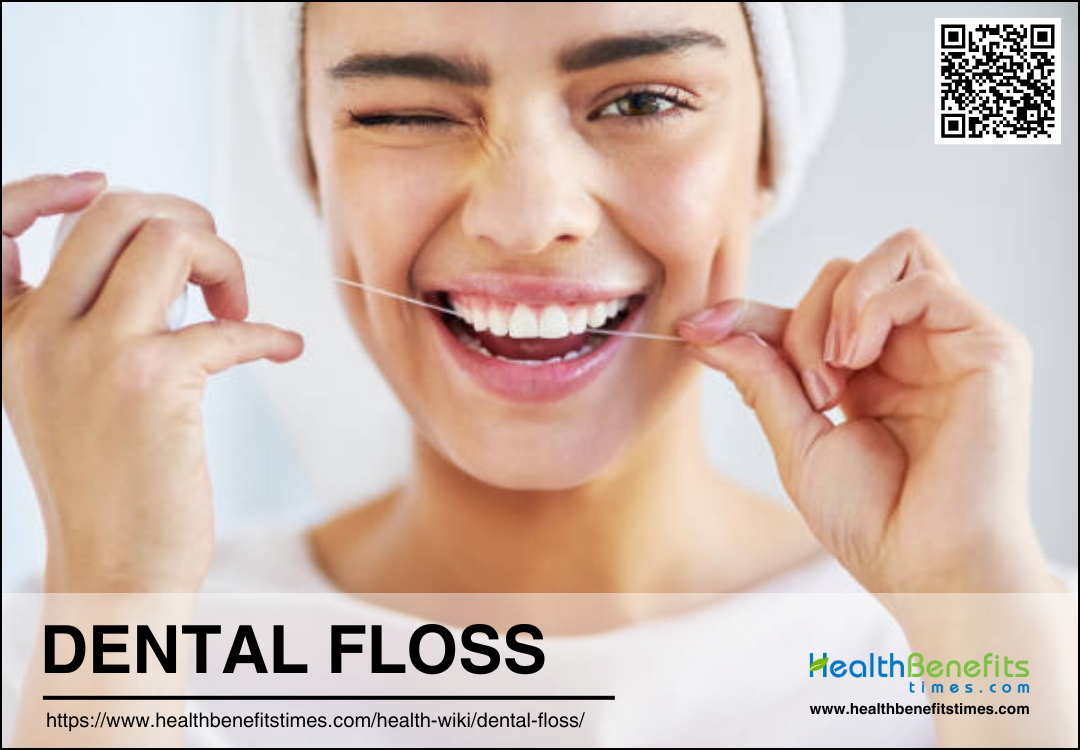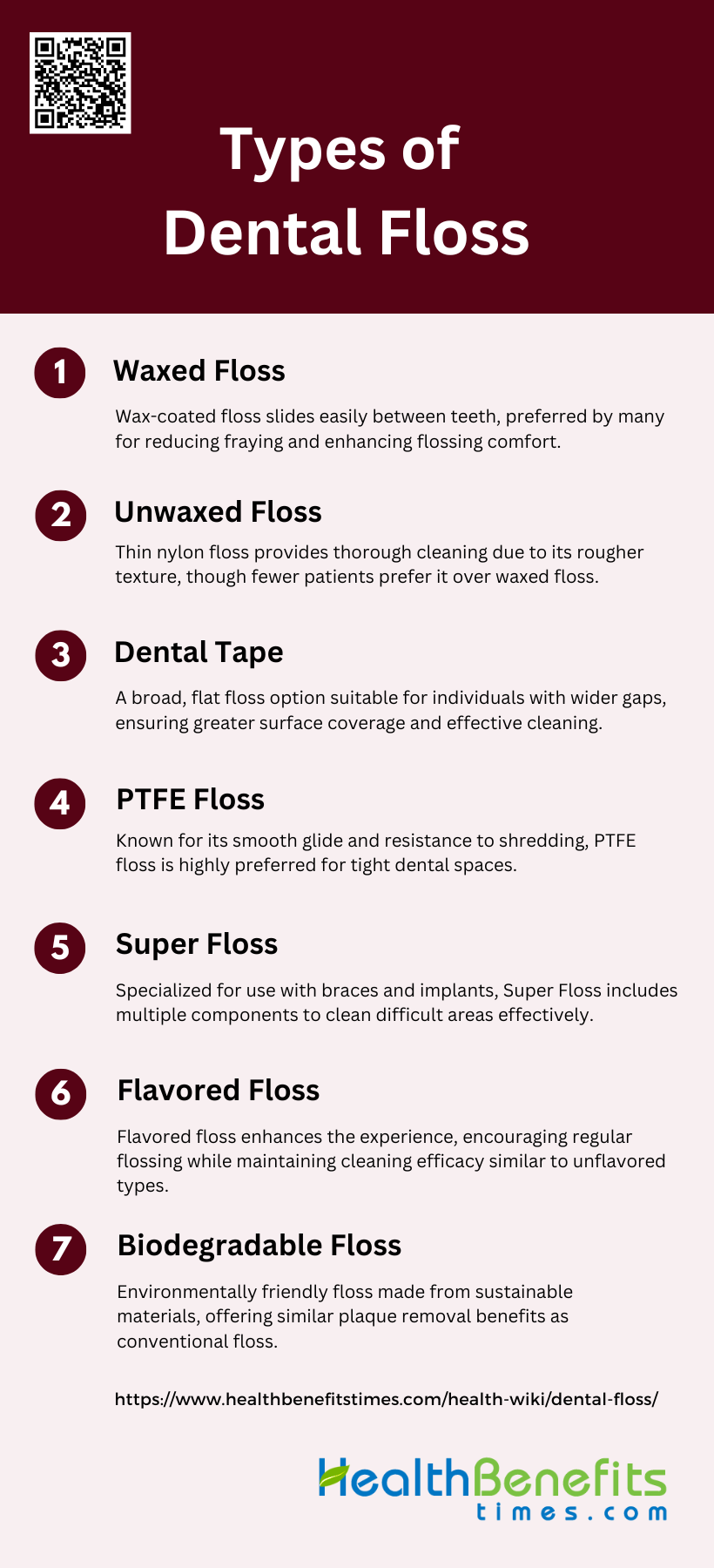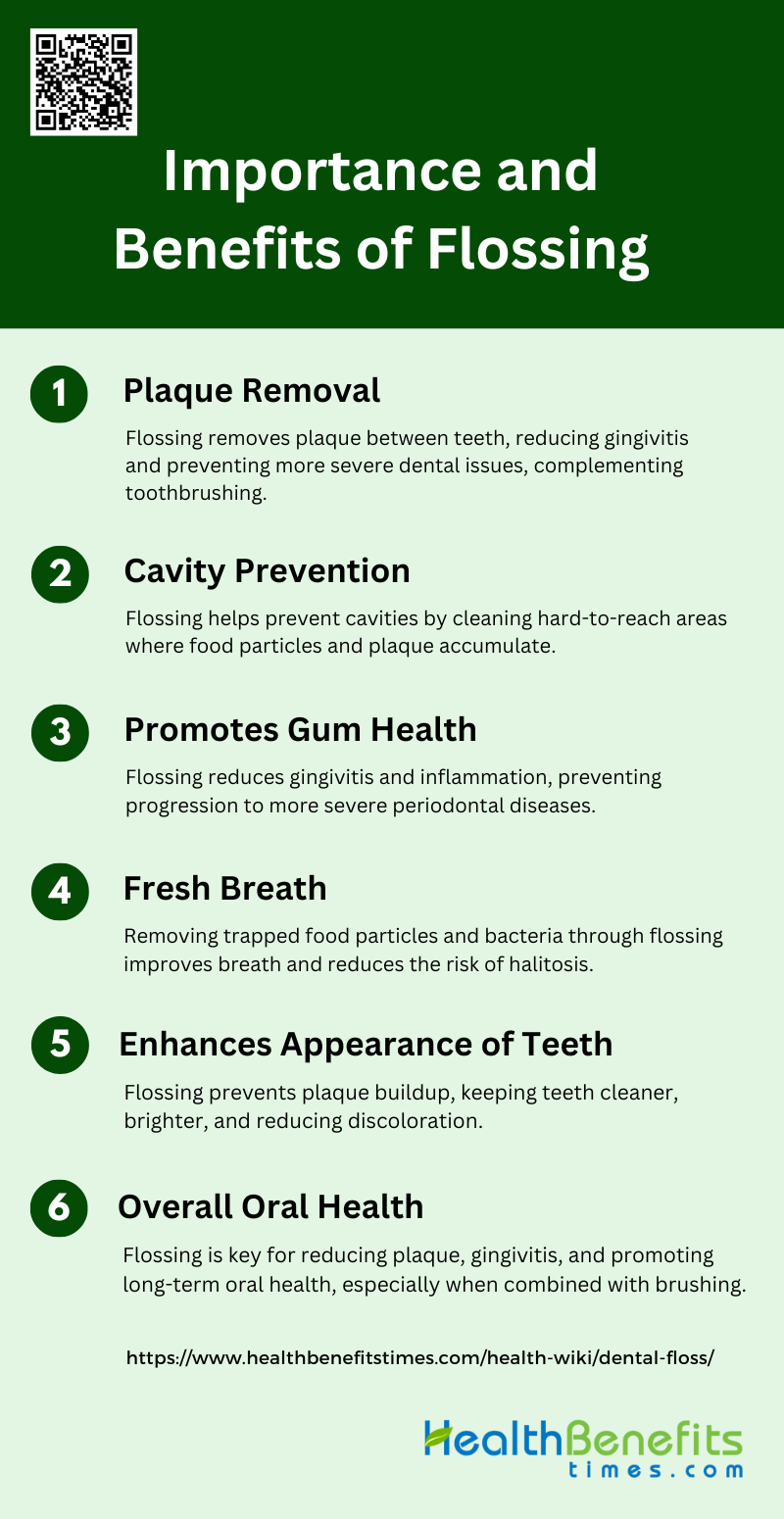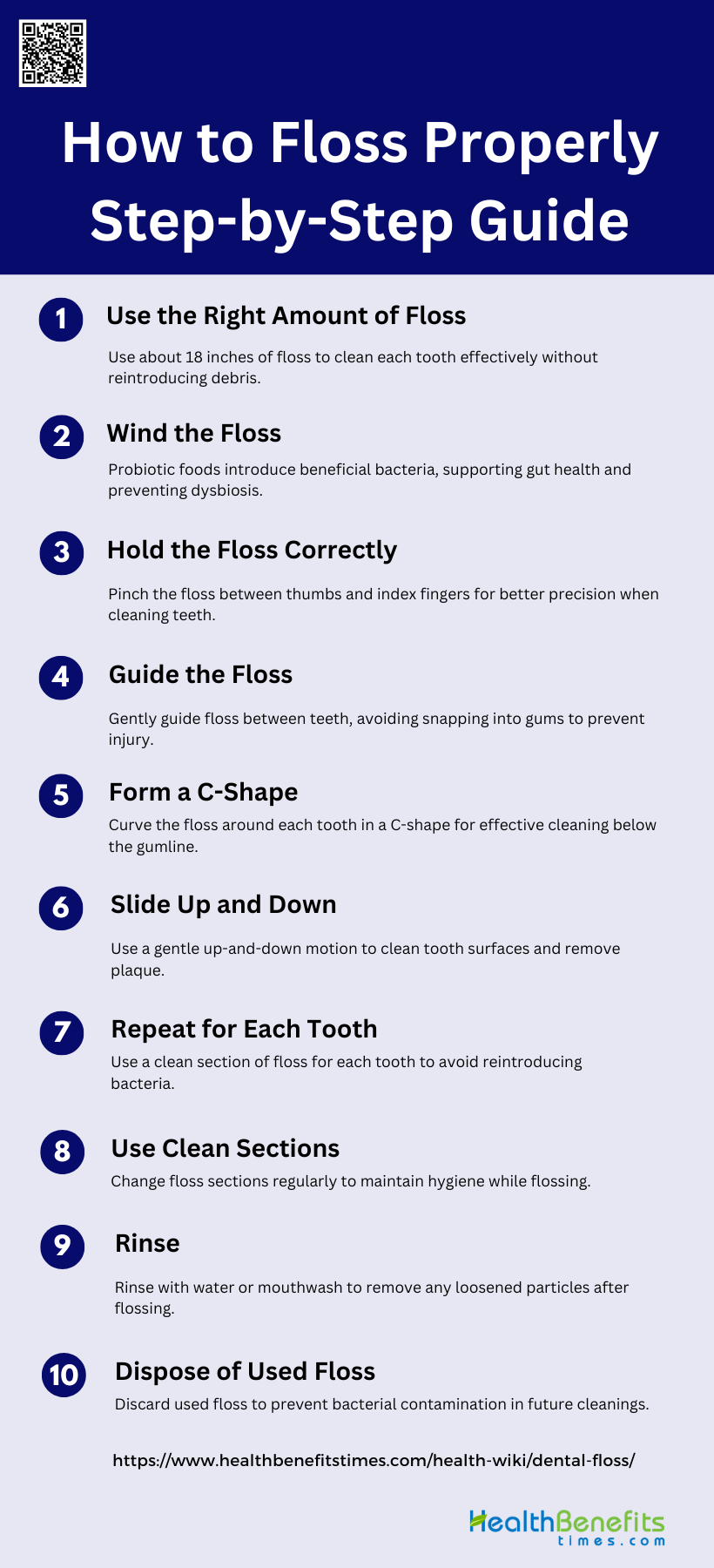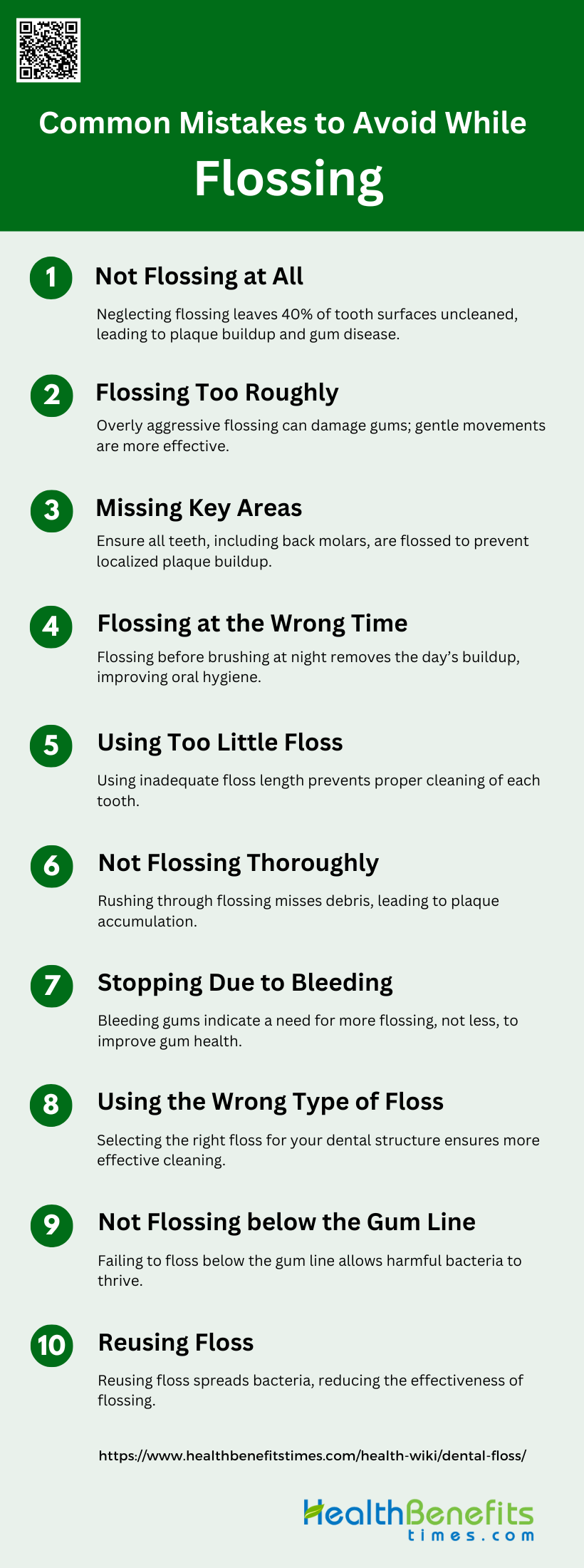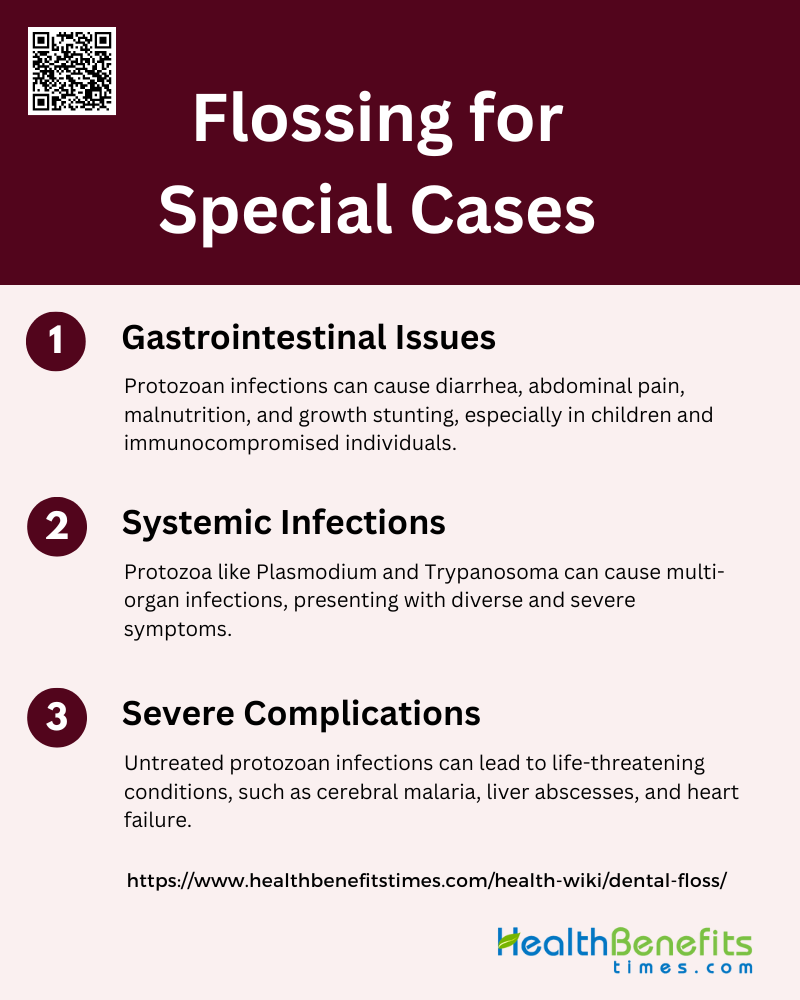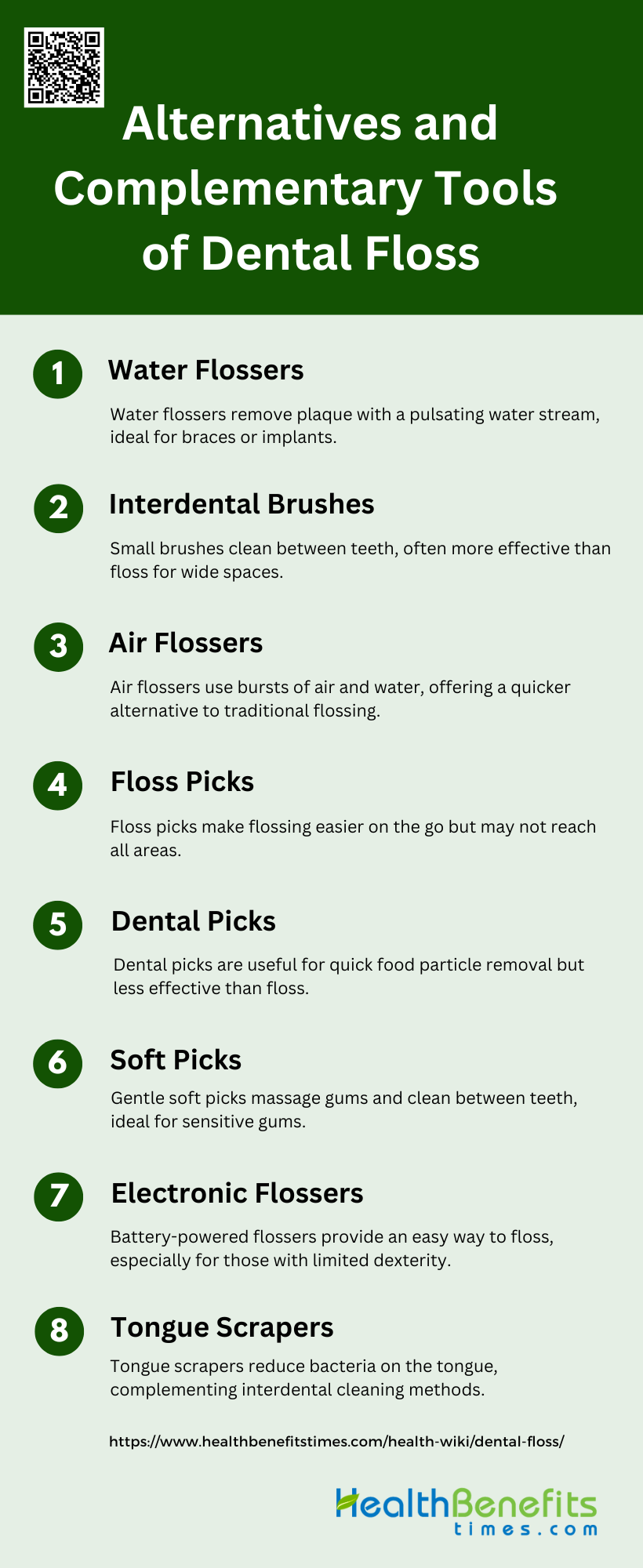Dental floss is a thin, flexible thread-like material specifically designed for oral hygiene purposes. It is used to remove food particles, plaque, and bacteria from between teeth and along the gumline, where toothbrushes cannot effectively reach. Made from various materials such as nylon filaments or plastic ribbons, dental floss comes in different varieties, including waxed, unwaxed, flavored, and even biodegradable options. Regular use of dental floss, typically recommended once daily, is an essential part of maintaining good oral health, as it helps prevent tooth decay, gum disease, and bad breath by cleaning areas that are often missed during regular brushing. Proper flossing technique involves gently guiding the floss between teeth and along the gumline in a rubbing motion, ensuring thorough cleaning without causing damage to the gums.
Types of Dental Floss
Maintaining good oral hygiene is essential for overall health, and flossing plays a crucial role in this. Various types of dental floss are available to cater to different needs and preferences. Below are some common types of dental floss and their unique features:
1. Waxed Floss
Waxed dental floss is coated with a thin layer of wax, which makes it easier to slide between teeth and reduces the likelihood of fraying. Studies have shown that waxed floss is generally preferred by patients due to its ease of use and smooth gliding properties. For instance, a study found that 79% of patients preferred waxed floss over unwaxed floss after sampling both types. Additionally, waxed floss has been found to be slightly more effective in reducing gingival bleeding and crevicular fluid flow compared to unwaxed floss, although the differences were not clinically significant. Overall, waxed floss is a popular choice for many due to its user-friendly characteristics.
2. Unwaxed Floss
Unwaxed dental floss is made of thin nylon strands and lacks the coating found in waxed floss. This type of floss is often favored by those who believe it provides a more thorough cleaning due to its slightly rougher texture. However, patient preference tends to lean towards waxed floss, with only 21% of patients in a study preferring unwaxed floss. Despite this, unwaxed floss is effective in plaque removal and maintaining gingival health, showing no significant difference in efficacy compared to waxed floss. It is a viable option for those who prefer a more traditional flossing experience.
3. Dental Tape
Dental tape is a broader and flatter type of floss, which can be more comfortable for individuals with wider gaps between their teeth. It is particularly effective in removing interproximal biofilm and is often recommended for those who find regular floss too thin or difficult to handle. A study comparing dental tape to other floss types found it to be effective in controlling interproximal biofilm, although it required higher forces at insertion for maxillary contacts2. Dental tape is a good alternative for those who need a wider flossing material to cover more surface area between teeth.
4. PTFE (Polytetrafluorethylene) Floss
PTFE floss, also known as Teflon floss, is known for its superior gliding capabilities and resistance to shredding. Studies have shown that PTFE floss requires less force to pass through tight contacts compared to nylon floss, making it easier to use. Additionally, PTFE floss has been found to be more effective in reducing interproximal bleeding sites compared to nylon waxed floss. Its smooth texture and durability make it a preferred choice for many users, with 74.5% of study participants favoring PTFE floss over nylon waxed floss.
5. Super Floss
Super Floss is a specialized type of floss designed for cleaning around dental appliances such as braces, bridges, and implants. It typically consists of three components: a stiffened-end threader, spongy floss, and regular floss. This combination allows for effective cleaning in hard-to-reach areas. A study comparing Super Floss to other flossing methods found it to be effective in controlling interproximal biofilm, making it a viable alternative for those with complex dental needs. Super Floss is particularly beneficial for individuals who require a more versatile flossing tool to maintain oral hygiene around dental work.
6. Flavored Floss
Flavored dental floss is coated with various flavors, such as mint, to enhance the flossing experience and encourage regular use. A study found that 56% of patients preferred mint-flavored waxed floss over plain waxed floss, indicating that flavor can play a significant role in patient preference. Flavored floss provides the same cleaning efficacy as unflavored floss but adds an element of freshness and enjoyment to the routine. It is an excellent option for those who may need extra motivation to maintain their flossing habits.
7. Biodegradable Floss
Biodegradable floss is an eco-friendly alternative to traditional floss, made from materials that break down more easily in the environment. This type of floss is gaining popularity among environmentally conscious consumers. While specific studies on the efficacy of biodegradable floss are limited, it is generally designed to perform similarly to conventional floss in terms of plaque removal and gingival health. The growing interest in sustainable products makes biodegradable floss an attractive option for those looking to reduce their environmental impact while maintaining good oral hygiene.
Importance and benefits of Flossing
Flossing is a vital component of oral hygiene that offers numerous advantages beyond what brushing alone can achieve. It helps maintain the health of your teeth and gums, contributing to overall well-being. Below are some key benefits of flossing:
1. Plaque Removal
Flossing plays a crucial role in the removal of dental plaque, which is a sticky film of bacteria that forms on teeth. Plaque accumulation can lead to various oral health issues, including gingivitis and periodontitis. Studies have shown that flossing, in addition to toothbrushing, significantly reduces plaque levels compared to toothbrushing alone. For instance, flossing has been associated with a small but statistically significant reduction in plaque at one and three months. This reduction is essential for maintaining oral hygiene and preventing the onset of more severe dental conditions.
2. Cavity Prevention
While the direct evidence linking flossing to cavity prevention is limited, flossing helps remove food particles and plaque from areas that a toothbrush cannot reach, such as between the teeth. This interdental cleaning is crucial for preventing dental caries (cavities) in these hard-to-reach areas. Although some studies have not conclusively shown that flossing alone prevents cavities, it is widely accepted that flossing contributes to overall oral hygiene, which in turn helps in reducing the risk of cavities. Regular flossing, combined with other oral hygiene practices, can thus play a role in cavity prevention.
3. Promotes Gum Health
Flossing is particularly effective in promoting gum health by reducing gingivitis, an early stage of gum disease characterized by inflammation and bleeding of the gums. Research indicates that flossing, in addition to toothbrushing, significantly reduces gingivitis at various time points, including one, three, and six months. This reduction in gingivitis is crucial for preventing the progression to more severe periodontal diseases, which can lead to tooth loss and other complications. Therefore, incorporating flossing into daily oral hygiene routines is essential for maintaining healthy gums.
4. Fresh Breath
One of the benefits of flossing is its ability to contribute to fresher breath. Bad breath, or halitosis, is often caused by the accumulation of food particles and bacteria in the mouth, particularly in areas that are difficult to clean with a toothbrush alone. Flossing helps remove these particles and reduces the bacterial load, thereby improving breath odor. Although specific studies on flossing and halitosis are limited, the general consensus is that effective plaque removal through flossing can lead to fresher breath. Regular flossing, therefore, is an important practice for maintaining oral freshness.
5. Enhances Appearance of Teeth
Flossing can enhance the appearance of teeth by preventing the buildup of plaque and tartar, which can cause discoloration and staining. By removing plaque from between the teeth, flossing helps maintain a cleaner and brighter smile. Additionally, healthy gums, which are promoted by regular flossing, contribute to the overall aesthetic of the teeth and mouth. Studies have shown that flossing, along with other interdental cleaning methods, is effective in maintaining oral hygiene and preventing the visual signs of dental diseases. Thus, flossing is an important practice for those seeking to enhance the appearance of their teeth.
6. Overall Oral Health
Flossing is a critical component of overall oral health. It helps in the prevention and management of periodontal diseases, reduces the risk of dental caries, and promotes healthy gums. Research has consistently shown that flossing, in addition to toothbrushing, provides significant benefits in reducing plaque and gingivitis, which are key factors in maintaining oral health. Moreover, flossing has been associated with lower levels of oral disease and fewer missing teeth in older adults, further underscoring its importance in a comprehensive oral hygiene routine. Therefore, regular flossing is essential for achieving and maintaining optimal oral health.
How to Floss Properly Step-by-Step Guide
Flossing correctly is crucial for maintaining optimal oral hygiene. Following the proper technique ensures that you effectively remove plaque and food particles from between your teeth. Below is a step-by-step guide to help you floss properly:
1. Use the right amount of floss
To floss properly, start by using the right amount of floss. Dental professionals recommend using about 18 inches of floss, which allows you to use a clean section for each tooth. This length ensures that you can effectively remove plaque and food particles from between your teeth without reintroducing debris into your mouth. Using the correct amount of floss is crucial for maintaining good oral hygiene and preventing periodontal diseases and dental caries.
2. Wind the floss
Next, wind the floss around your fingers. Take the 18 inches of floss and wind most of it around the middle finger of one hand, and the rest around the middle finger of the other hand. This technique provides a firm grip and allows you to control the floss as you move it between your teeth. Proper winding ensures that you can easily maneuver the floss and reach all areas of your mouth, which is essential for effective plaque removal.
3. Hold the floss correctly
Hold the floss correctly by pinching it between your thumbs and index fingers. This grip gives you better control and precision as you guide the floss between your teeth. Holding the floss correctly is important to avoid injuring your gums and to ensure that you can effectively clean the interdental spaces. Proper technique is key to reducing gingivitis and maintaining overall oral health.
4. Guide the floss
Gently guide the floss between your teeth using a back-and-forth motion. Be careful not to snap the floss into your gums, as this can cause injury. Instead, guide it smoothly to avoid damaging the delicate gum tissue. This step is crucial for effectively removing plaque and food particles without causing harm to your gums, which can lead to inflammation and bleeding.
5. Form a C-shape
Once the floss is between your teeth, curve it into a C-shape around one tooth. This shape allows the floss to wrap around the tooth and reach below the gumline, where plaque and food particles often accumulate. Forming a C-shape ensures that you clean both sides of the tooth and the gumline, which is essential for preventing periodontal diseases and maintaining good oral hygiene.
6. Slide up and down
Slide the floss up and down against the tooth surface and under the gumline. This motion helps to dislodge and remove plaque and food particles that are stuck between your teeth. Be sure to use a gentle but firm motion to avoid damaging your gums. Sliding the floss up and down is an effective way to clean the interdental spaces and prevent the buildup of plaque, which can lead to dental caries and gum disease.
7. Repeat for each tooth
Repeat the process for each tooth, using a clean section of floss for each one. This ensures that you do not transfer plaque and debris from one tooth to another. Flossing each tooth individually is important for thorough cleaning and for preventing the spread of bacteria and plaque throughout your mouth. Consistent and proper flossing can significantly reduce the risk of gingivitis and other oral health issues.
8. Use clean sections
As you move from tooth to tooth, use a clean section of floss. This practice helps to avoid reintroducing plaque and debris into your mouth. Using clean sections of floss is essential for maintaining effective oral hygiene and for ensuring that each tooth is properly cleaned. This step is particularly important for preventing the spread of bacteria and for maintaining overall oral health.
9. Rinse
After flossing, rinse your mouth with water or an antiseptic mouthwash. Rinsing helps to remove any remaining particles and bacteria that were dislodged during flossing. This step is important for completing the cleaning process and for ensuring that your mouth is free of debris and bacteria. Rinsing can also help to freshen your breath and promote overall oral hygiene.
10. Dispose of used floss
Finally, dispose of the used floss properly. Do not reuse floss, as it can harbor bacteria and lose its effectiveness. Disposing of used floss ensures that you maintain good oral hygiene and prevent the reintroduction of bacteria into your mouth. Proper disposal is a simple but important step in maintaining effective flossing habits and promoting overall oral health.
Tips for effective flossing
Flossing is a crucial part of maintaining oral hygiene, but doing it correctly can make all the difference. Here are some tips to help you floss more effectively and keep your teeth and gums healthy:
1. Best Time of Day to Floss (Before or After Brushing)
Flossing before brushing is generally more effective in reducing interdental plaque and increasing fluoride retention. A study comparing the sequence of brushing and flossing found that flossing first followed by brushing significantly reduced interdental and whole plaque more than brushing first and then flossing. Additionally, fluoride concentrations in interdental plaque were higher when flossing was done before brushing, suggesting better fluoride retention in the interdental areas. Therefore, flossing before brushing can enhance the overall effectiveness of oral hygiene practices.
2. How Often You Should Floss
Daily flossing is recommended to maintain optimal oral health. Regular flossing helps in the mechanical removal of dental plaque, which is the primary cause of dental caries and periodontal diseases. Studies have shown that using floss in addition to toothbrushing can reduce gingivitis and plaque more effectively than toothbrushing alone. Although the evidence varies in quality, the consensus is that daily flossing is beneficial for preventing and controlling periodontal diseases and dental caries. Therefore, incorporating flossing into your daily oral hygiene routine is essential for maintaining healthy gums and teeth.
3. Using Floss with Other Tools like Water Flossers or Interdental Brushes for Better Results
Combining floss with other interdental cleaning tools such as water flossers or interdental brushes can provide superior results in maintaining oral health. Interdental brushes have been shown to be more effective than floss in reducing plaque and gingival inflammation, especially in patients with periodontal disease. Water flossers also offer beneficial adjunctive effects on bleeding and gingival indices. Using a combination of these tools can enhance plaque removal and improve gingival health, making it easier for individuals to maintain effective oral hygiene. Therefore, integrating multiple interdental cleaning devices into your routine can lead to better oral health outcomes.
Common Mistakes to Avoid While Flossing
Flossing is a crucial part of oral hygiene, but it’s easy to make mistakes that can reduce its effectiveness or even harm your gums. Here are some common mistakes to avoid to ensure you’re flossing correctly:
1. Not flossing at all
One of the most significant mistakes people make is completely neglecting to floss. While brushing is essential, it only cleans about 60% of your tooth surfaces. Flossing is crucial for removing plaque and food particles from between teeth and along the gum line, areas that your toothbrush can’t effectively reach. Regular flossing helps prevent gum disease, tooth decay, and bad breath. Make flossing a daily habit, ideally before bedtime, to maintain optimal oral health and prevent long-term dental problems.
2. Flossing too roughly
Many people floss too aggressively, which can damage gums and tooth enamel. Proper flossing technique involves gently sliding the floss between teeth and along the gum line, rather than snapping it forcefully into place. Use a gentle up-and-down motion against the sides of each tooth, forming a C-shape around the tooth as you go. This method effectively removes plaque and debris without causing harm to your gums or teeth. If you experience pain or bleeding while flossing, it may be a sign that you’re using too much force.
3. Missing key areas
A common mistake is not flossing all the necessary areas in your mouth. It’s crucial to floss between every tooth, including the back molars and hard-to-reach spaces. Pay special attention to the areas where your teeth touch, as these are prime spots for plaque buildup. Don’t forget to floss behind your last molars as well. Consistently missing certain areas can lead to localized gum disease or tooth decay. To ensure you’re not overlooking any spots, develop a systematic approach, starting from one side of your mouth and working your way around to the other side.
4. Flossing at the wrong time
While flossing at any time is better than not flossing at all, there are optimal times to incorporate this habit into your oral hygiene routine. Many dentists recommend flossing before brushing your teeth, especially at night. This sequence allows you to loosen and remove plaque and food particles from between your teeth, which can then be more effectively brushed away. Flossing before bed is particularly important as it removes the day’s accumulation of debris, preventing bacteria from thriving in your mouth overnight when saliva production is reduced.
5. Using too little floss
Using an insufficient amount of floss is a common error that can lead to ineffective cleaning. Start with about 18 inches of floss, which allows you to use a fresh section for each tooth. This length ensures that you’re not reintroducing bacteria from one area to another. Wrap most of the floss around your middle fingers, leaving about 1-2 inches of floss to work with between your hands. As you move from tooth to tooth, unwind clean floss from one finger and wind the used floss onto the other. This technique helps maintain hygiene throughout the flossing process.
6. Not flossing thoroughly
Rushing through the flossing process or not being thorough enough can leave plaque and food particles behind. Take your time to clean each tooth surface carefully, including the sides and the area just below the gum line. Use a gentle rubbing motion to dislodge plaque and debris. It’s important to clean both sides of each tooth, not just the spaces between them. Aim to spend at least two to three minutes on your flossing routine to ensure you’re giving each tooth the attention it needs for effective cleaning.
7. Stopping due to bleeding
Many people stop flossing when they notice their gums bleeding, but this is often a sign that flossing is needed more, not less. Bleeding gums can indicate gingivitis or early-stage gum disease, which is often reversible with proper oral hygiene. If you experience bleeding, continue to floss gently each day. Over time, as your gum health improves, the bleeding should subside. However, if bleeding persists for more than a week or two of regular, gentle flossing, consult your dentist to rule out more serious gum issues.
8. Using the wrong type of floss
Not all floss is created equal, and using the wrong type for your specific needs can lead to ineffective cleaning. There are various types of floss available, including waxed, unwaxed, thick, thin, and flavored options. People with tightly spaced teeth may benefit from waxed or glide floss, while those with wider spaces might prefer thicker, unwaxed floss. If you have braces or bridges, consider using a floss threader or specialized orthodontic floss. Experiment with different types to find the one that works best for your teeth and is most comfortable for you to use regularly.
9. Not flossing below the gum line
A critical mistake is failing to floss below the gum line, where harmful bacteria can accumulate and lead to periodontal disease. When flossing, gently guide the floss down to the point where the tooth meets the gum, then carefully slide it under the gum line. Form a C-shape around each tooth and use an up-and-down motion to clean this crucial area. Be gentle to avoid injuring the delicate gum tissue, but thorough enough to remove plaque and food particles. This practice helps prevent gum inflammation and maintains the health of your periodontal pockets.
10. Reusing floss
Reusing floss is a dangerous habit that can reintroduce bacteria into your mouth and potentially cause infection. Floss is designed for single use and should be discarded after each flossing session. Used floss harbors bacteria, food particles, and plaque that you’ve removed from your teeth. Reusing it spreads these contaminants to other areas of your mouth, defeating the purpose of flossing. Always use a fresh section of floss for each tooth and discard the entire piece after use. This practice ensures optimal hygiene and effectiveness in your flossing routine.
Flossing for Special Cases
Flossing can be more complicated in certain situations, such as with braces, dental bridges, or when teaching children. Here are some tips to help you floss effectively in these special cases:
1. Flossing with Braces
Flossing with braces can be challenging due to the wires and brackets that obstruct the flossing process. Tools like floss threaders are essential for navigating around these obstacles. Floss threaders act like a needle, allowing the floss to be threaded under the main wire of the braces, making it easier to clean between teeth and around the brackets. This method ensures that plaque and food particles are effectively removed, reducing the risk of gum disease and cavities. Proper technique and consistency are crucial for maintaining oral hygiene with braces, as improper flossing can lead to complications such as gingivitis and decalcification.
2. Flossing with Dental Bridges or Implants
Flossing with dental bridges or implants requires special techniques and tools to ensure thorough cleaning. Traditional floss may not be effective in these cases, and specialized floss like super floss, which has a stiff end for threading, a spongy section for cleaning around the bridge, and regular floss for under the gumline, is recommended. Interdental brushes and water flossers can also be beneficial. These tools help in removing plaque and food particles from hard-to-reach areas, preventing peri-implantitis and other complications. Consistent and proper flossing is essential to maintain the longevity and health of dental bridges and implants.
3. Child-Friendly Flossing
Encouraging children to floss can be challenging, but using engaging tools and techniques can make the process easier and more effective. Devices like GumChucks, which are designed to assist children with proper flossing technique, have shown to be effective in improving interdental plaque removal and gingival health. Additionally, involving parents in the flossing routine by using reward systems and providing corrective feedback can help maintain improved flossing skills in children. Addressing common barriers such as lack of motivation and manual dexterity issues is crucial, as these factors significantly impact children’s compliance with flossing. Making flossing a fun and rewarding activity can foster better oral hygiene habits in children.
Alternatives and complementary tools of Dental Floss
Maintaining optimal oral hygiene is crucial for overall health, and while dental floss is a popular choice, several other tools can complement or replace it. These alternatives cater to different needs and preferences, ensuring everyone can achieve a clean and healthy mouth. Below are some effective options:
1. Water Flossers
Water flossers, also known as oral irrigators, use a stream of pulsating water to remove food particles and plaque between teeth and below the gumline. They are particularly beneficial for individuals with braces, implants, or dental bridges, as they can reach areas that traditional floss might miss. Studies have shown that water flossers can reduce gingivitis and plaque more effectively than toothbrushing alone, although the evidence is of low certainty. They are also easier to use for people with limited manual dexterity, making them a practical alternative to traditional flossing methods.
2. Interdental Brushes
Interdental brushes are small brushes designed to clean between teeth, particularly in areas where there is sufficient space. They are often easier to use than dental floss and have been shown to be effective in reducing gingivitis and plaque. Research indicates that interdental brushes may be more effective than floss in reducing gingivitis and plaque when used in addition to toothbrushing. They are especially recommended for individuals with type II and type III open embrasure spaces, where they can reach and clean more effectively than floss.
3. Air Flossers
Air flossers use bursts of air and micro-droplets of water to remove plaque and food particles from between teeth. They are designed to be a quicker and easier alternative to traditional flossing. While there is limited evidence on their effectiveness compared to other interdental cleaning devices, they are generally considered easier to use, especially for individuals with limited dexterity. Air flossers can be a good option for those who find traditional flossing cumbersome or difficult.
4. Floss Picks
Floss picks are small plastic devices with a piece of dental floss stretched between two prongs. They are designed to make flossing easier and more convenient, especially for people who struggle with traditional floss. Floss picks can be effective in removing plaque and food particles between teeth, although they may not be as effective as traditional floss in reaching all areas. They are a practical option for on-the-go use and can help maintain oral hygiene when traditional flossing is not feasible.
5. Dental Picks
Dental picks, also known as toothpicks, are small sticks used to remove food particles and plaque from between teeth. They can be made of wood, plastic, or rubber. While they are not as effective as floss or interdental brushes in removing plaque, they can be useful for quick clean-ups after meals. Studies suggest that wooden cleaning sticks can reduce bleeding sites but are less effective in reducing plaque compared to other interdental cleaning devices. They are best used as a supplementary tool rather than a primary method of interdental cleaning.
6. Soft Picks
Soft picks are flexible, rubber-like devices designed to clean between teeth and massage the gums. They are gentle on the gums and can be easier to use than traditional floss, especially for individuals with sensitive gums or limited dexterity. Soft picks can help reduce plaque and gingivitis when used in addition to toothbrushing. They are particularly useful for people with braces or dental work that makes traditional flossing difficult. However, their effectiveness compared to other interdental cleaning devices is still being studied.
7. Electronic Flossers
Electronic flossers are battery-operated devices that use gentle vibrations to help remove plaque and food particles from between teeth. They are designed to make flossing easier and more effective, especially for individuals with limited manual dexterity. While there is limited evidence on their effectiveness compared to traditional floss, they can be a convenient and user-friendly option for maintaining oral hygiene. Electronic flossers can be particularly beneficial for people who find traditional flossing techniques challenging.
8. Tongue Scrapers
Tongue scrapers are tools used to clean the surface of the tongue, removing bacteria, food debris, and dead cells. While not a direct alternative to dental floss, they are an important complementary tool for maintaining overall oral hygiene. Tongue scraping can help reduce bad breath and improve the sense of taste. Regular use of tongue scrapers can contribute to a cleaner mouth and fresher breath, making them a valuable addition to daily oral care routines.
FAQs
1. Can dental floss be recycled?
No, traditional dental floss is typically made from nylon or Teflon, which are not biodegradable or recyclable. However, there are biodegradable options available that are more eco-friendly.
2. What is the difference between dental floss and dental tape?
Dental floss is thinner and round, while dental tape is broader and flatter. Dental tape may be better suited for people with wider gaps between their teeth, while floss is typically used for tighter spaces.
3. Can flossing cause gums to recede?
Improper flossing technique, such as snapping the floss into the gums or using excessive force, can irritate the gums and potentially contribute to gum recession over time. Always floss gently and avoid aggressive movements.
4. Is it safe to use flavored dental floss daily?
Yes, flavored dental floss is safe for daily use. The flavoring is typically added to enhance the flossing experience without affecting its effectiveness in removing plaque and food particles.
5. How long does a dental floss spool last?
This depends on how much floss you use per session. Typically, a spool of dental floss containing around 50 yards of floss should last one to two months if you use about 18 inches per session daily.
6. Can I use dental floss for children, or is there special floss for kids?
Yes, you can use regular dental floss for children, but there are also special floss picks and flossers designed for children that are easier for them to handle and use.
7. Is it okay to reuse dental floss?
No, dental floss is designed for single use. Reusing floss can reintroduce bacteria and plaque back into your mouth, potentially causing infections or gum issues.
8. How does dental floss differ from water flossers?
Dental floss physically removes plaque and debris by scraping it away from the teeth, while water flossers use a stream of water to flush out debris from between the teeth and gums. Both can complement each other in a dental hygiene routine.
9. Can flossing help with teeth whitening?
Flossing can help reduce stains caused by plaque buildup between teeth. However, it does not have the same whitening effect as professional treatments or whitening toothpaste.
10. Should I floss if I have sensitive gums?
Yes, you should still floss if you have sensitive gums, but make sure to do so gently. Sensitive gums can sometimes indicate the need for more regular flossing to remove bacteria that cause irritation. If discomfort persists, consult a dentist.


